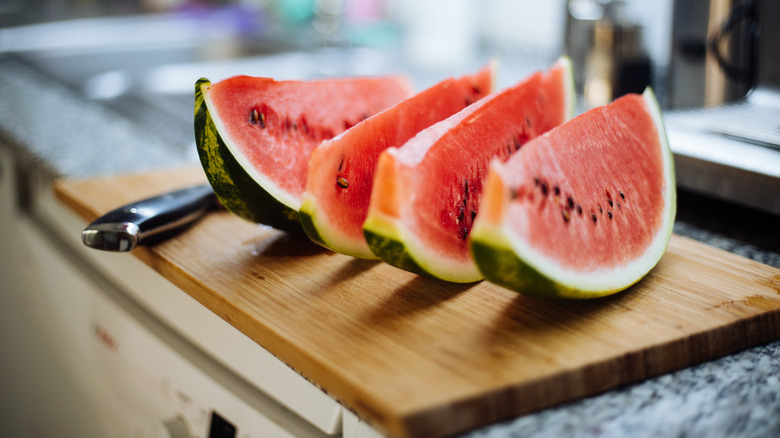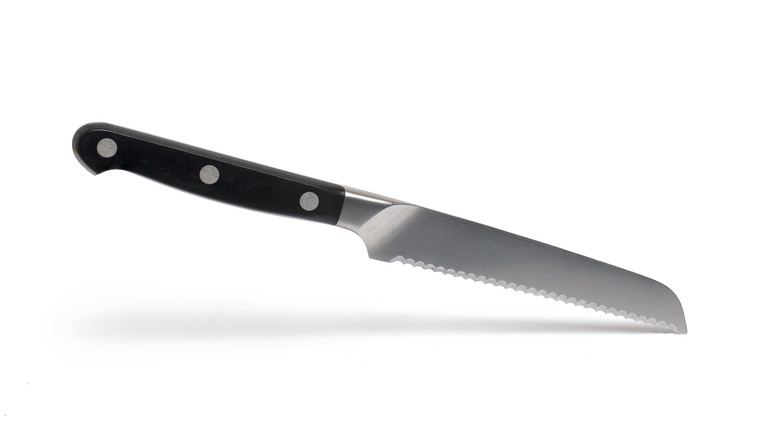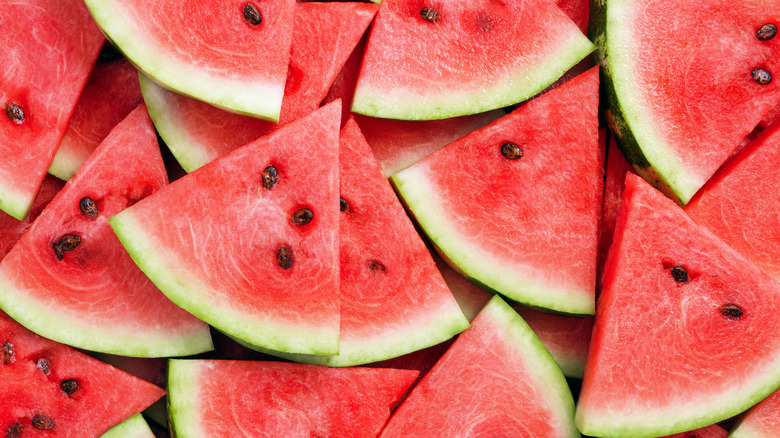Here's The Best Kind Of Knife For Cutting Watermelon
There's nothing more convenient than pre-cut watermelon from the grocery store. The upside is that they make for easier snacking — no messy cutting required. But, the downside is that they're usually far more expensive than their whole counterparts. Moreover, they typically don't taste as fresh either. For those keen on getting the best — and tastiest — bang for your buck, opt for the uncut varieties. When it comes time for cutting, just be sure to ditch the straight-edged chef's knife in favor of a serrated knife, which will allow you to slice through the thick, green skin with ease thanks to its saw-like blade.
A true kitchen staple, serrated knives are designed to cut through foods that are firm on the outside yet soft and tender on the inside. And people have, quite literally, been using them to hack through tough materials for ages. Early humans used notched stone knives as far back as the Stone Age to cut through the likes of wood and bones. Fast forward to today, and serrated knives are perhaps best known for their ability to cut through a loaf of crusty bread. (Hence their nickname of "bread knife.") But, the toothed-edge cutting tool is capable of cutting so much more, from fibrous meats like roast and brisket to fruits like pineapple and, of course, juicy watermelons.
Serrated knives are good for more than just bread
Long serrated knives are undoubtedly the best thing since sliced bread. They can certainly handle a French baguette or a loaf of sourdough like nobody's business. But you can use a bread knife to efficiently cut up a watermelon, too. In fact, it's the best tool to use to tackle the tough, green rind without breaking a sweat. That's because the knife's long blade and pointy teeth pack more bite, allowing them to do the hard work by gripping the fruit's thick skin. They offer more control than the average chef's knife and will enable you to carve through the firm exterior without using as much pressure.
The handy knives also work wonders on other tough fruits, such as pineapple, and other melons, like cantaloupe. And surprisingly, serrated knives are also the best knife for tomatoes. They're able to perforate the delicate red skin without mashing the flesh or sending tomato juice squirting out. But, when it comes to easily slicing a watermelon, there are a few best practices for cutting the fruit into slices, triangles, and chunks.
How to cut watermelon like a pro
Wondering how to cut watermelon sticks for easy snacking? First, grab a serrated knife and then thoroughly wash your melon. (After all, with such a large surface, they could harbor mold and bacteria, among other unappetizing things.) Simply cut the watermelon in half crosswise and lay the flat sides down on the cutting board one by one, using the bread knife to easily slice off the ends. Cut the melon into 1.5- to 2-inch pieces going one way, turn it 90 degrees, and cut across again so you're left with juicy little sticks.
For triangle-shaped pieces, cut the fruit in half lengthwise and then repeat the step on both halves so you're left with four pieces. Place the quarters rind side down and cut across so that you're left with delicious-looking pie-shaped wedges. Lastly, forgo store-bought, pre-cut watermelon chunks by easily cutting cubes at home. Use the serrated blade to remove the ends, stand the melon on one end, and cut it in half. Lay it on one edge and carefully trim off the rind, leaving you with just the delectable pink flesh. Use the aforementioned cutting method for sticks to chop up the fruit and then cut the sticks into smaller bite-sized pieces. Your watermelon never tasted fresher.



